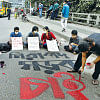Make highway travel safe, especially for women

The similarity between the highway robbery on the Dhaka-Tangail route on Tuesday night and the one that occurred over three months ago on the same route raises troubling questions about what the authorities are really doing to maintain law and order. According to a case filed by a victim of the recent incident, the robbers boarded the bus posing as passengers, took control of it using knives and machetes, looted passengers, and sexually assaulted several female passengers. The case statement also said the robbers drove the bus for several hours before disembarking at different points along the highway.
Victims of the February 17 robbery, where several women were also assaulted, also described similar tactics used by robbers. Following that incident, protests were held demanding safety for women in public spaces, including public transport. Yet, harassment and assault of female travellers by criminal gangs or the moral police continue to occur, with the relevant authorities often unaware of or unmoved by these crimes until they cause a stir on social media.
In response to the February incident, the government deployed additional police forces along the routes to the northern districts. However, the occurrence of the recent robbery suggests that such measures, even if implemented dutifully, are not sufficient. We also need stronger surveillance and swifter, stricter legal action against perpetrators to deter prospective criminals. According to a Prothom Alo report, similar incidents occurred in 2023 and 2022 as well, but trials have yet to begin due to procedural and legal loopholes. This lax enforcement clearly emboldens criminals.
At the same time, the effectiveness of increased patrols should also be questioned. As a report published in this daily a month after the February 17 robbery revealed, the highway police lack adequate logistical support and modern, technology-driven policing systems. Are there enough CCTV cameras installed along highways? Are there properly staffed control rooms to monitor vehicle movement? Are officials capable of identifying erratic or off-route bus movement? The answers are not hard to guess.
Therefore, to prevent such attacks, the government must not only increase police presence but also work with stakeholders, especially transport owners' associations, to find sustainable solutions to highway robberies and ensure that long-distance travel is safe, particularly for women. With Eid-ul-Azha only about two weeks away, it must act fast. During such festivals, many unauthorised buses operate on long routes to meet heightened transport demand, increasing chances of untoward incidents. So, such operations must be strictly monitored and brought under control. Whether by road or river, long-distance journeys must be safe for all.


 For all latest news, follow The Daily Star's Google News channel.
For all latest news, follow The Daily Star's Google News channel. 










Comments